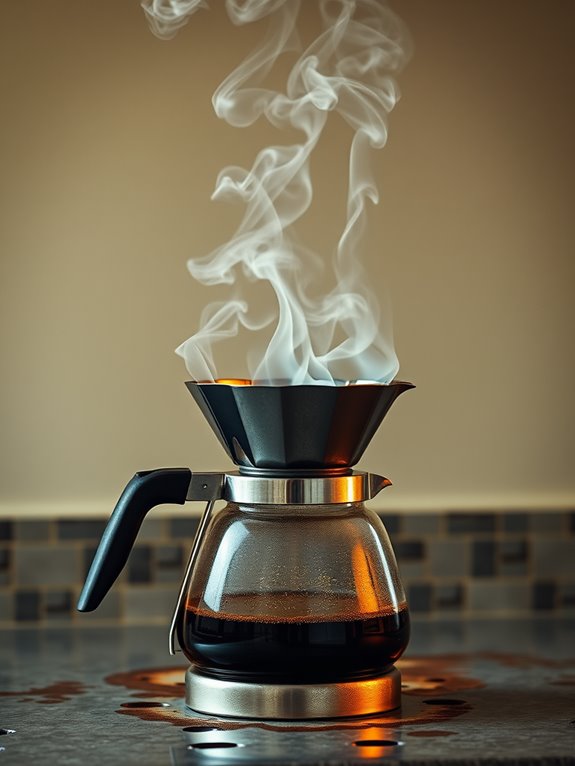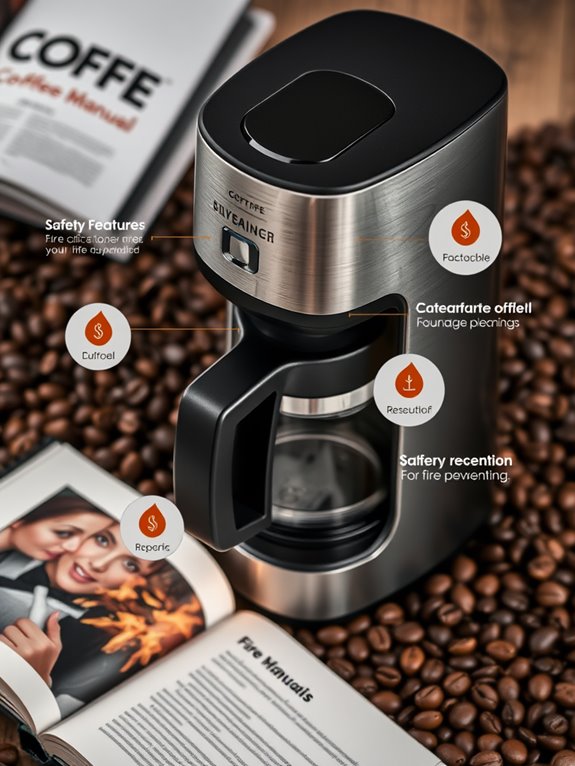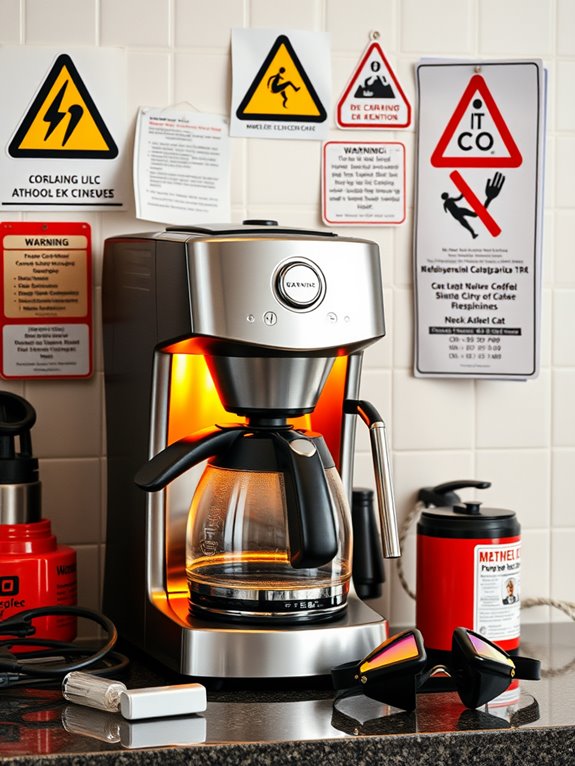Can Leaving a Coffee Maker on Cause a Fire
Leaving a coffee maker on unattended isn't just risky; it can indeed cause a fire. If electrical malfunctions occur, especially with faulty wiring or design defects, overheating is a potential threat. Without an automatic shutoff feature, prolonged operation may lead to smoking or ignition. Regular cleaning and safety checks further reduce risk. While coffee maker fires aren't the most common, they do happen. Want to learn how to guarantee your appliance is safe and reliable?
Key Takeaways
- Leaving a coffee maker on can lead to overheating and potential fire hazards.
- Electrical malfunctions in coffee makers can cause smoke or fires if left unattended.
- Design defects, like faulty temperature controls, may result in continuous heating and fire risk.
- Regular maintenance and cleaning can prevent overheating and potential fire incidents.
- Unplugging a coffee maker when not in use significantly reduces fire risks.
Risk Factors of Leaving a Coffee Maker On

When it comes to the risk factors of leaving a coffee maker on, understanding the potential dangers can help you make safer choices.
Electrical malfunctions, such as faulty wiring, can lead to fires, especially if not addressed promptly. Regular maintenance and choosing models with automatic shutoff features can mitigate these risks. An estimated 22 consumers report smoke or fire from coffee makers each year, highlighting the importance of being vigilant. Unattended use considerably increases fire hazards, so unplugging the machine when not in use is essential.
Design and safety features, like dual thermal cutoffs and UL listings, enhance safety.
Environmental factors, like poor ventilation and placing the coffee maker on combustible surfaces, also contribute to overheating and fire risks.
Common Causes of Coffee Maker Fires
Coffee makers, while convenient, can pose fire risks if not used or maintained properly.
Let's examine some common causes of coffee maker fires:
1. Overheating: Leaving the appliance on too long can cause wiring to melt or ignite.
Guarantee proper ventilation and clean regularly to avoid blockages.
2. Mechanical Faults and Electrical Issues: Faulty wiring can lead to overheating and smoking, posing serious risks.
Electrical malfunctions account for many fire incidents.
3. Design and Manufacturing Defects: Flaws like faulty temperature controls and lack of automatic shut-off mechanisms can cause continuous heating and potential fires.
Always be vigilant about these risks.
Regular vinegar solution cleaning helps prevent mineral buildup that can lead to overheating and potential fire hazards.
Statistics on Coffee Maker Fire Incidents

Exploring the statistics on coffee maker fire incidents reveals important observations into their frequency and impact. From 2013 to 2018, around 300 fires were reported, averaging 60 fires annually. This figure highlights the risk, although coffee maker fires are rarer than other kitchen appliance fires.
In 1996, 500 fires caused $4.4 million in damages, yet by 1998, incidents dropped by 40%. Despite this, injuries remained unchanged.
Electrical malfunctions contribute to 7% of residential fires, hinting at a need for caution. Annually, kitchen fires, including those from coffee makers, lead to $1 billion in property damage, stressing their potential severity.
Prevention Measures for Coffee Maker Fires
Ensuring your coffee maker is safe to use can greatly reduce the risk of fires, offering peace of mind in your daily routine.
Let's examine key prevention measures. First, place your coffee maker on a noncombustible surface and keep flammable items away.
Second, unplug the coffee maker when not in use, especially overnight or during weekends.
Third, regularly inspect for frayed wires or blockages to prevent overheating.
For added safety, run a cycle of hot water first before brewing your coffee to ensure proper operation.
Here's a quick checklist:
- Maintenance: Clean regularly to prevent blockages.
- Safety: Monitor while in use; keep water away.
- Inspection: Check GFCI outlets and circuit breakers for proper function.
Stay safe and enjoy your coffee!
Responsibilities of Coffee Maker Manufacturers

When it comes to keeping your coffee maker safe, individual actions play a key role, but manufacturers bear significant responsibilities too. They design and test machines rigorously to prevent overheating and electrical issues, using advanced tech for rapid iterations. High-precision tools and robotic assembly guarantee quality, with skilled technicians overseeing the process. Detailed training and clear documentation help users operate machines safely. Modern coffee makers are specifically engineered to maintain proper brewing temperatures between 195-205°F. Let's investigate their responsibilities through this table:
| Responsibility | Action | Importance |
|---|---|---|
| Design and Testing | Prevent overheating | Guarantees safety |
| Manufacturing | Robotic assembly | Consistency and reliability |
| Training and Docs | Clear user guides | Safe operation |
Regulatory Actions and Safety Standards
While guaranteeing the safety of your coffee maker hinges largely on your actions, regulatory bodies play an essential role in setting safety standards that manufacturers must follow.
Key regulations include:
- Safety Standards: Coffee makers should meet UL 197 for commercial use or UL 1082 for household use, guaranteeing they're safe to operate.
- Oversight and Recalls: The Consumer Product Safety Commission (CPSC) monitors products, issuing recalls for defective coffee makers to prevent fires.
- Automatic Shutoff: New models are recommended to include an automatic shutoff feature, reducing fire risk if left unattended.
Check CPSC for recalls and guarantee GFCI receptacles function properly.
Consumer Awareness and Safety Practices

As we move from discussing regulatory standards to your role in guaranteeing coffee maker safety, it's crucial to understand how your actions can prevent fires.
Overheating often results from blockages or leaving the coffee maker on too long. To avoid this, unplug the device when not in use, and regularly clean it to prevent blockages.
Place it on a noncombustible surface, keeping flammable materials away. Choose models with an automatic shutoff feature, and verify they're UL listed.
Educate yourself and others on safe practices, as awareness can greatly reduce the risk of fire.
Regular inspection of your coffee maker's water reservoir seals can prevent leaks that might cause electrical hazards.
Let's investigate these safety measures together.







